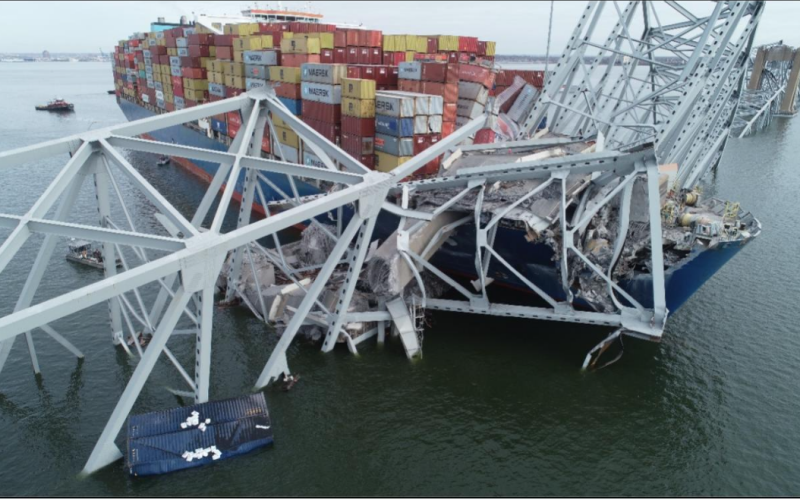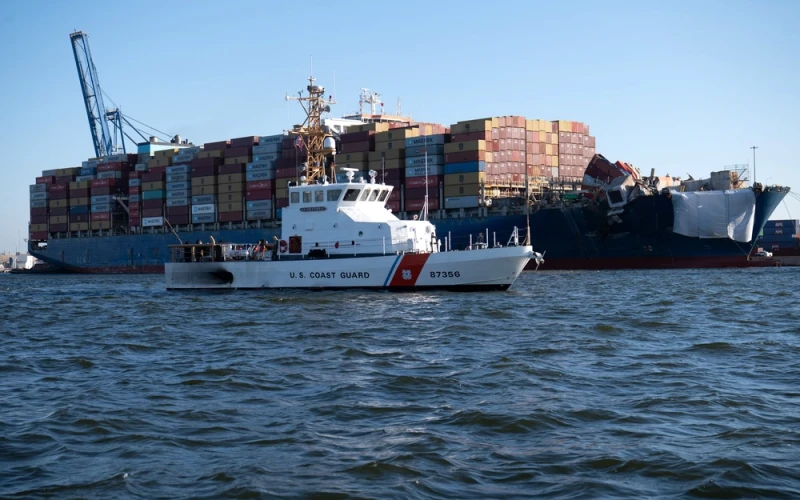The containership Dali got underway June 24 from the Port of Baltimore, about three months after its March 26 allision brought down the Francis Scott Key Bridge.
With four tugs and a Coast Guard cutter in its escort, the 985’ Dali departed the port around 8:30 a.m. Monday morning, on an expected 16 to 20-hour transit to Norfolk, Va.
Six construction workers died when the Dali lost power while approaching the bridge on March 26, slamming into a pier support and collapsing the span. Amid an urgent salvage effort the Dali was finally removed from the collapse site May 20 and had been tied up in Baltimore.
The Dali moved Monday under its own power with a full crew of 22 and six salvage experts from Resolve Marine, according to a Coast Guard statement. Four tugboats accompanied the ship and the salvage vessel from Resolve Marine followed closely behind.
The plan called for the Dali is to transit directly to Virginia International Gateway, where about 1,500 containers would be offloaded to reduce draft. Then the vessel was “scheduled to transit further to Norfolk International Terminal where it is slated to undergo continued salvage and repairs from damage caused during the bridge collapse,” according to the Coast Guard.
The 87’ Coast Guard cutter Sailfish was maintaining a 500-yard safety zone around the moving ship. Coast Guard watchstanders at command centers in the Fifth Coast Guard District, in Portsmouth, Virginia and Sector Maryland-National Capital Region and Sector Virginia monitored the ship’s movement.
An investigation by the National Transportation Safety Board is focused on failures in the Dali’s electrical system – two in the hours before its March 26 departure, and the blackout that left the ship out of control leading to the allision.
In a June 24 update, NTSB investigators reported how electrical breakers, identified HR1 and LR1, “unexpectedly opened when the vessel was three ship lengths from the Key Bridge, causing the first blackout (loss of electrical power) to all shipboard lighting and most equipment.”
While examining and testing the vessel’s electrical power distribution system and control circuitry, investigators working with crew members and other parties to the investigation, saw an interruption in the control circuit for HR1’s undervoltage release. That device opens a breaker when voltage falls below predetermined thresholds.
Investigators removed a terminal block from the control circuit for HR1’s undervoltage release and two portions of control wiring associated with the terminal block.
“We continue to examine the removed components at the NTSB Materials Laboratory,” according to the agency statement. “We will continue to evaluate the design and operation of the vessel’s electrical power distribution system and investigate all aspects of the accident to determine the probable cause and identify potential safety recommendations
The ship’s 22 crew members remained on board after the accident, stranded at the bridge site while wreckage was cleared from around the vessel. Last week an agreement reached in federal court between the city of Baltimore, the ship owners and other parties allowed crew members to return home to Sri Lanka and India, with the provision that they be available for court depositions.






